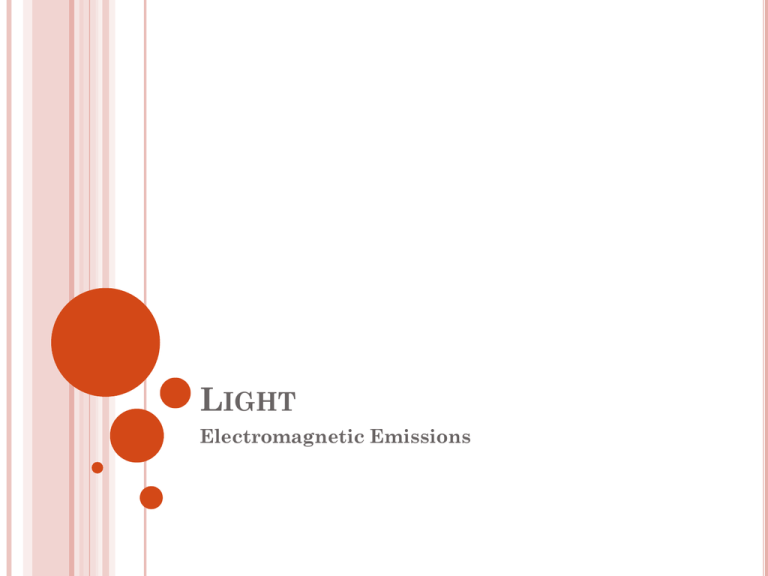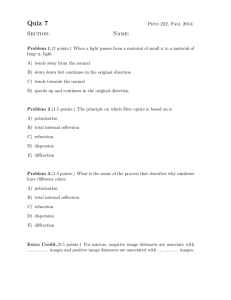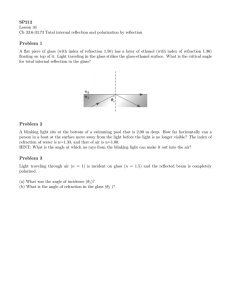L IGHT Electromagnetic Emissions
advertisement

LIGHT Electromagnetic Emissions THEORIES OF LIGHT Light used to be thought of as a stream of particles. This means light would not be able to diffract. This means light can travel through a vacuum (doesn’t need a medium to travel in). Light also shows properties of waves. Light is able to diffract, and can move around obstacles. THE FACTS OF LIGHT Light is the range of frequencies of electromagnetic waves that stimulate the retina of the eye (λ between 400 and 700nm). Light can be defined using the Ray Model of light. Light has a finite speed. THE ELECTROMAGNETIC SPECTRUM The visible spectrum is a small portion of larger picture. The wavelengths are measured in meters. Larger wavelengths are related to smaller frequencies. ELECTROMAGNETIC SPECTRUM THE RAY MODEL OF LIGHT The Ray Model of light states that a ray is a narrow beam of light that travels in a straight path. Assumes light travels in a straight line. Ignores the wave-like properties of light. Used to describe how light is reflected and refracted. THE SPEED OF LIGHT Galileo first hypothesized that the speed of light was an actual number – not instantaneous. He could not prove this though. Danish astronomer Ole Roemer determined that it took light 22 minutes to travel Earth’s diameter based on measurements of the orbital period of one of Jupiter’s moons. THE SPEED OF LIGHT Albert Michelson measured the speed of light to be 2.997996 x 108 m/s. This earned him a Nobel prize. Accepted speed of light is: c = 3x108m/s LIGHT AND MATTER Transparent: transmit light without distorting the image. Translucent: A material that transmits light but objects cannot be seen clearly through them. Opaque: Transmit no light; all light is absorbed or reflected. PRISMS AND COLOR PRISMS AND COLOR Isaac Newton noticed that light is made of up a spectrum of colors, that combined is called white light. COLORS OF LIGHT Red, Blue and Green are called the primary colors of light. Yellow, Cyan and Magenta are secondary. Complimentary colors (1 primary and the opposing secondary) create white light. COLORS OF LIGHT THIN FILMS – LIGHT AS A WAVE In bubbles and oil films rainbows appear. Not explained by the ray model of light – no absorption or white light separation! This is a result of constructive and destructive interference of light waves! POLARIZATION OF LIGHT – LIGHT AS A WAVE Polarization is the property of transverse waves that describes the orientation of the waves. Light waves move in all many directions. The polarization is perpendicular to the direction the light travels. Sound is NOT polarized…why? Polarizers are machines or substances that take the unpolarized incident waves and convert them all to a single plane of polarization. POLARIZATION OF LIGHT Polarizers reduce the amount of light that enters an area by cutting out ½ the amount of light. The end result is light that is less intense. POLARIZATION OF LIGHT Reflected light can also be polarized. This produces clearer images. REFLECTION Light can be reflected. (Specular Reflection) Regular reflected light results in the angle of incidence and the angle of reflection to be the same. Regular reflection requires a smooth surface with reflective properties! This is known as the Law of Reflection! REFLECTION Specular Reflection occurs on flat, smooth surfaces. Therefore to see the reflected light the observer must look at the reflected right at the right angle. Diffuse reflection results in a scattering of the rays into multiple directions. The reflected rays can be seen from multiple angles. REFLECTION When light strikes a smooth surface with no reflective properties the result is diffuse reflection (scattered light). REFRACTION Light can be refracted. When light strikes a new medium some of the light is reflected, some enters the medium. This light that enters the medium changes angles and velocities. REFRACTION The speed of light in a vacuum: c = 3x108m/s. This value is true for ALL forms of electromagnetic waves in a vacuum. In a different medium the waves slow down. The rate at which they slow down depends upon the density of the medium. INDEX OF REFRACTION To determine the speed of light in a particular medium the following equation can be used: c/v = n n is known as the index of refraction. Each substance has its own index of refraction. The values for n are never less than 1!!! Substance Index of Refraction Vacuum 1.0000 Air 1.0003 Water 1.33 Glass 1.50 Diamond 2.42 Ethyl Alcohol 1.36 REFRACTION When light passes from one medium to the next: Some light is reflected at the boundary Some is transmitted into the new medium The light that enters the new medium will change angles and speed! REFRACTION – AIR TO WATER Initially the light is in the air. The light that enters the water will change angles and velocity (based on n) Depends upon 5 things: Angle of the light entering the new medium (incident angle) θ1 Index of refraction of the incident medium n1 Angle of the light in the new medium θ2 Index of refraction of new medium n2 Normal = imaginary line drawn perpendicular to the medium normal SNELL’S LAW Snell’s Law puts all of this information together to create the Law of Refraction. n1sinθ1 = n2sinθ2 When the ray enters a medium where the speed is slower, the angle always bends towards the normal. When the ray enters a medium where the speed is faster, the angle bends away from the normal. SNELL’S LAW n for air is lower (higher v) than n for water light bends toward the normal! n for water is greater than the n for air light bends away from the normal!

